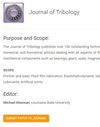Developing elastic-plastic material models for pressure measurement films in a steel-steel contact for smooth and rough surfaces
IF 3
3区 工程技术
Q2 ENGINEERING, MECHANICAL
引用次数: 0
Abstract
The contact zone between two steel components can be identified by utilizing a pressure measurement film in the contact between them. To reduce the number of necessary experiments, it is possible to simulate the contact situation using ‘finite element analysis’. This analysis requires material models for the contact partners and for the pressure measurement films. It is known that the pressure measurement film deforms not only elastically but also plastically. Taking this plastic deformation into account requires an appropriate material model such as the Drucker-Prager model. Based on published data of experiments with pressure measurement films that had been inserted between smooth and rough Hertzian bodies, we developed material models for three pressure measurement films. The roughness of a Hertzian body was studied by determining multiple pressure-clearance curves for three different surface roughnesses and for three different pressure measurement films. These curves were developed with micro models, which represented a small section of the rough contact surface. An average curve for each material was then implemented in the macro model for each roughness representing the contact situation. Subsequently, the resulting contact areas were compared with the published experimental data. This comparison showed that the material model for the smooth contact was able to emulate the experimentally determined contact areas. Including the pressure-clearance curves in the material model allowed the simulation of the rough contact situation. However, the deviation between the simulated and the experimental data was slightly larger for the rough surface than for the smooth surface.建立了用于光滑和粗糙表面的钢-钢接触压力测量膜的弹塑性材料模型
两个钢构件之间的接触区域可以通过在它们之间的接触中利用压力测量膜来识别。为了减少必要的实验次数,可以使用“有限元分析”来模拟接触情况。这种分析需要用于接触伙伴和压力测量膜的材料模型。已知压力测量膜不仅弹性变形,而且塑性变形。考虑到这种塑性变形需要适当的材料模型,例如德鲁克-普拉格模型。基于已发表的插入光滑赫兹体和粗糙赫兹体之间的压力测量膜的实验数据,我们开发了三种压力测量薄膜的材料模型。通过测定三种不同表面粗糙度和三种不同压力测量膜的多个压力间隙曲线,研究了赫兹体的粗糙度。这些曲线是用微观模型开发的,这些模型代表了粗糙接触表面的一小部分。然后在代表接触情况的每个粗糙度的宏观模型中实现每个材料的平均曲线。随后,将得到的接触面积与公布的实验数据进行比较。这种比较表明,用于平滑接触的材料模型能够模拟实验确定的接触面积。在材料模型中包括压力-间隙曲线允许模拟粗糙接触情况。然而,粗糙表面的模拟数据和实验数据之间的偏差略大于光滑表面的偏差。
本文章由计算机程序翻译,如有差异,请以英文原文为准。
求助全文
约1分钟内获得全文
求助全文
来源期刊
CiteScore
4.20
自引率
12.00%
发文量
117
审稿时长
4.1 months
期刊介绍:
The Journal of Tribology publishes over 100 outstanding technical articles of permanent interest to the tribology community annually and attracts articles by tribologists from around the world. The journal features a mix of experimental, numerical, and theoretical articles dealing with all aspects of the field. In addition to being of interest to engineers and other scientists doing research in the field, the Journal is also of great importance to engineers who design or use mechanical components such as bearings, gears, seals, magnetic recording heads and disks, or prosthetic joints, or who are involved with manufacturing processes.
Scope: Friction and wear; Fluid film lubrication; Elastohydrodynamic lubrication; Surface properties and characterization; Contact mechanics; Magnetic recordings; Tribological systems; Seals; Bearing design and technology; Gears; Metalworking; Lubricants; Artificial joints

 求助内容:
求助内容: 应助结果提醒方式:
应助结果提醒方式:


